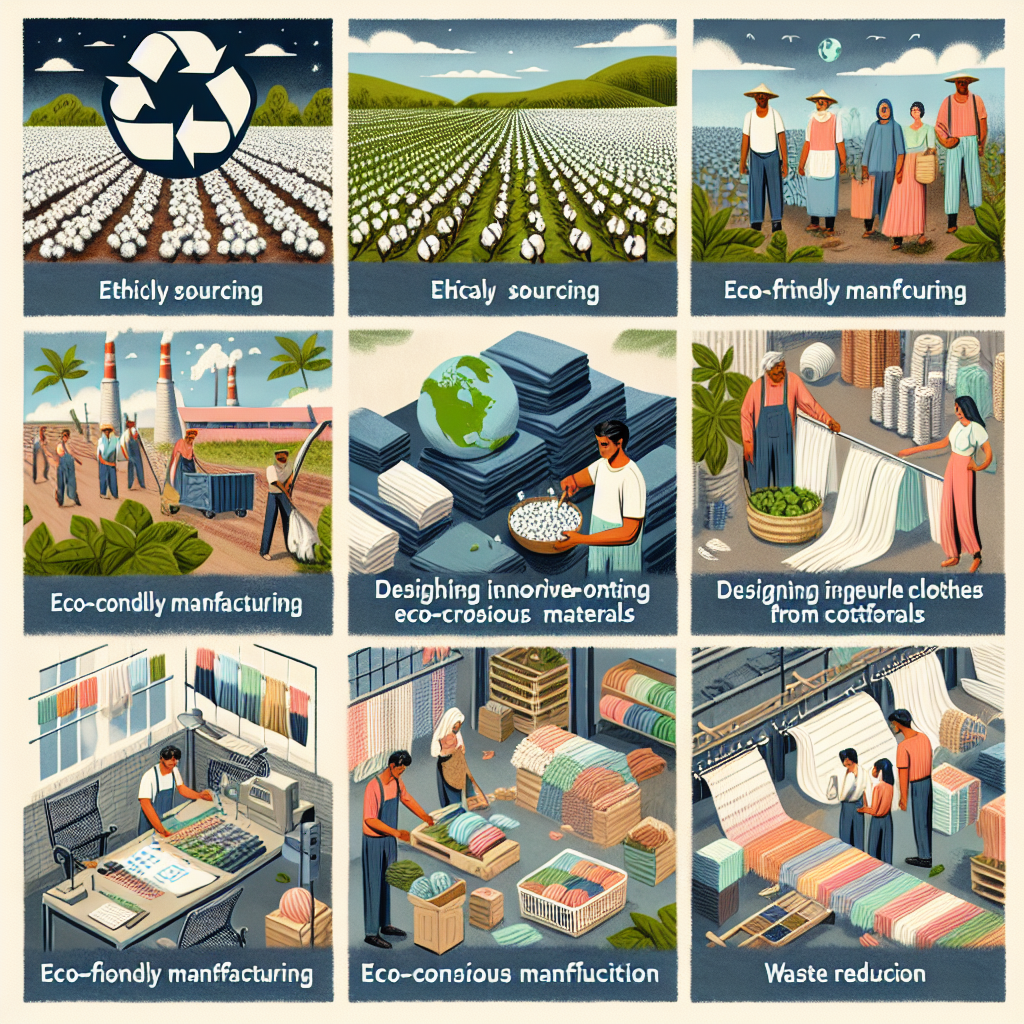Are you passionate about fashion and sustainability? If so, you’re in the right place. In this article, we’ll guide you through the process of creating and managing a sustainable fashion line, providing you with valuable insights and practical tips along the way. From sourcing eco-friendly materials to implementing ethical production practices, we’ve got you covered. Get ready to embark on a journey towards creating a fashion brand that not only looks good but also makes a positive impact on the planet. Let’s get started!
- Choosing Sustainable Materials
- Designing Sustainable Products
- Ethical Production Practices
- Reducing Waste and Recycling
- Promoting a Circular Economy
- Marketing and Branding Strategies
- Building a Sustainable Supply Chain
- Sustainable Fashion Certification
- Managing Costs and Pricing
- Consumer Education and Transparency
Choosing Sustainable Materials
Choosing sustainable materials is a crucial step in creating a sustainable fashion line. When researching sustainable materials, it is important to consider their environmental impact, ethical sourcing practices, and their overall life cycle.
Researching sustainable materials
To start, you can research and identify materials that are considered sustainable alternatives to conventional options. Look for materials such as organic cotton, hemp, linen, and Tencel, which are known for their minimal environmental impact. It is also important to consider materials that are made from recycled or upcycled sources, as they help reduce waste and minimize the use of new resources.
Examining the life cycle of materials
When selecting materials, it is essential to examine their life cycle. This involves considering the environmental impact from the extraction or production stage, through the manufacturing process, and finally to the end of the product’s life. Look for materials that have a lower carbon footprint, require less water and energy in production, and can be easily recycled or biodegraded.
Considering the environmental impact of materials
Another important aspect to consider is the environmental impact of the materials you choose. Look for materials that are produced using eco-friendly processes, such as low-impact dyes and water-efficient manufacturing techniques. Avoid materials that contribute to deforestation, use harmful chemicals, or produce excessive waste during production.
Sourcing ethical and fair-trade materials
In addition to sustainability, it is crucial to source materials that are ethically and fair-trade certified. This ensures that the workers involved in producing the materials are paid fair wages, work in safe conditions, and are not subjected to exploitation. Look for certifications like Fairtrade, Global Organic Textile Standard (GOTS), and Fair Wear Foundation to ensure that your materials are sourced ethically.
Designing Sustainable Products
Once you have chosen sustainable materials, the next step is to design products that are both fashionable and environmentally friendly. Designing sustainable products involves considering their longevity, versatility, and minimizing waste during the production process.
Designing timeless and versatile pieces
To create sustainable products, designers should focus on designing timeless and versatile pieces. This means opting for classic silhouettes and styles that can withstand changing trends and seasons. By designing garments that can be worn for multiple occasions and easily paired with other items, you can help minimize the desire for constant new purchases and encourage a more sustainable approach to fashion consumption.
Creating multifunctional garments
Another way to promote sustainability in design is by creating multifunctional garments. This involves designing pieces that can be styled and worn in different ways, allowing the wearer to get more use out of a single garment. For example, a dress that can be transformed into a top or a skirt that can be worn as an overlay. This not only enhances the versatility of the product but also reduces the need for multiple items in a wardrobe.
Implementing zero-waste and upcycling techniques
Designers can also incorporate zero-waste and upcycling techniques into their design process. Zero-waste design aims to eliminate fabric waste by utilizing every bit of the fabric and minimizing the need for excess trimming. Upcycling involves giving new life to discarded materials or pre-existing garments by transforming them into new, unique pieces. By implementing these techniques, designers can create products that have a minimal impact on the environment and promote a circular economy.

Ethical Production Practices
Creating a sustainable fashion line goes beyond just the materials and design. It is crucial to ensure that ethical production practices are in place throughout the manufacturing process.
Working with fair-wage factories
One important aspect of ethical production is working with fair-wage factories. This means choosing manufacturers that provide fair compensation to their workers, ensuring that they earn a living wage for their work. By partnering with factories committed to fair wages, you can contribute to improving the livelihoods of workers in the fashion industry.
Ensuring safe working conditions
In addition to fair wages, it is essential to prioritize safe working conditions for the people involved in the production of your garments. This includes ensuring proper ventilation, sufficient lighting, and adequate facilities. Regular audits and inspections can help ensure that the factories comply with safety standards and provide a healthy working environment.
Reducing carbon footprint in production
To minimize the environmental impact of production, it is important to focus on reducing the carbon footprint. This can be achieved by implementing energy-efficient technologies, using renewable energy sources, and optimizing transportation and logistics. By reducing emissions during the production process, you can help mitigate climate change and contribute to a more sustainable fashion industry.
Implementing transparency in the supply chain
Transparency in the supply chain is essential for a sustainable fashion line. This involves tracing the journey of materials from their source to the final product, ensuring that ethical and sustainable practices are followed at every step. Implementing transparent supply chains helps build trust with consumers and allows them to make informed choices about the products they purchase.
Reducing Waste and Recycling
In the fashion industry, waste is a significant issue that needs to be addressed. By implementing strategies to reduce waste and recycling, you can minimize the environmental impact of your fashion line.
Implementing efficient inventory management
Efficient inventory management is crucial to reduce waste in the fashion industry. By accurately forecasting demand and production needs, you can avoid overproduction and excess inventory. This helps reduce the need for markdowns and prevents unsold garments from ending up in landfills.
Minimizing fabric waste during production
Another effective way to reduce waste is by minimizing fabric waste during the production process. Pattern cutting techniques, such as using computer-aided design (CAD) software and nesting patterns efficiently, can help optimize fabric usage and reduce waste. Additionally, considering the use of pre-consumer and post-consumer recycled fabrics can contribute to reducing waste in the industry.
Recycling and upcycling unsold or damaged garments
Inevitably, there may be garments that remain unsold or become damaged. Instead of disposing of them, consider recycling or upcycling these items. Recycling involves breaking down materials and transforming them into new products, while upcycling involves giving new life to the garments by transforming them into new designs or accessories. By implementing these measures, you can extend the lifespan of your products and reduce waste.
Implementing a take-back and recycling program
To further promote recycling and reduction of waste, consider implementing a take-back and recycling program. This allows customers to return their worn-out garments to your brand, which can then be properly recycled or upcycled. By taking responsibility for the entire lifecycle of your products, you demonstrate your commitment to sustainability and encourage customers to adopt more eco-friendly consumption habits.
Promoting a Circular Economy
Promoting a circular economy is a key element in creating a truly sustainable fashion line. A circular economy aims to eliminate waste and make the most of resources, creating a continuous loop of production, use, and recycling.
Educating consumers about sustainability
To promote a circular economy, it is essential to educate consumers about sustainability and the importance of their purchasing decisions. This can be done through informative content, social media campaigns, and collaborations with influencers and sustainable ambassadors. By raising awareness and providing information, you can empower consumers to make more sustainable choices.
Implementing rental and subscription services
Another way to promote a circular economy is by offering rental and subscription services. Instead of purchasing garments outright, customers can rent or subscribe to a variety of styles, allowing them to regularly update their wardrobes without contributing to overconsumption. This encourages a sharing economy and helps reduce the demand for new products.
Encouraging second-hand and vintage shopping
Promoting second-hand and vintage shopping is another important part of creating a circular economy. Encourage customers to shop at thrift stores, consignment shops, and online marketplaces for pre-loved items. By extending the lifespan of clothing and accessories, you contribute to reducing the demand for new production and contribute to a more sustainable fashion industry.
Marketing and Branding Strategies
To effectively communicate your commitment to sustainability and attract conscious consumers, it is crucial to develop marketing and branding strategies that highlight the sustainable practices of your fashion line.
Storytelling and communicating sustainability
Storytelling is a powerful tool that can be used to convey the sustainable values and mission of your brand. Share the story behind your products, highlighting the materials used, the ethical production practices in place, and the positive impact of choosing sustainable fashion. Authentic and transparent communication can help build a strong connection with consumers who prioritize sustainability.
Collaborating with influencers and sustainable ambassadors
Collaborating with influencers and sustainable ambassadors can amplify the reach of your message and make it more relatable to a broader audience. Partner with individuals who share the same values and align with your brand’s mission. By leveraging their influence and credibility, you can reach new audiences and inspire them to choose sustainable fashion.
Leveraging social media and digital platforms
Utilize social media and digital platforms to showcase your sustainable fashion line. Share behind-the-scenes glimpses of your production process, highlight the craftsmanship of your products, and engage with your audience through interactive content. By utilizing these platforms effectively, you can increase brand awareness and foster a community of like-minded individuals.
Utilizing eco-friendly packaging and labeling
To align with your sustainable values, it is essential to use eco-friendly packaging and labeling. Opt for recycled or biodegradable packaging materials and utilize minimal packaging where possible. Clearly communicate the eco-friendly aspects of your packaging to customers, showcasing your commitment to reducing waste and promoting sustainability.

Building a Sustainable Supply Chain
Building a sustainable supply chain is essential to ensure the integrity and sustainability of your fashion line. This involves working with ethical and sustainable suppliers, implementing traceability systems, and continuously monitoring and auditing your suppliers.
Working with sustainable and ethical suppliers
Collaborating with sustainable and ethical suppliers is crucial to ensure that your supply chain aligns with your values. Conduct thorough research to identify suppliers that prioritize sustainability, ethical practices, and transparency. Look for suppliers with certifications such as the Global Organic Textile Standard (GOTS) or the Responsible Wool Standard (RWS) to ensure the integrity of the materials you source.
Implementing traceability systems
Implementing traceability systems helps track and monitor the journey of materials from their source to the final product. This allows you to verify the sustainability and ethical practices followed throughout the supply chain. By having a clear understanding of where your materials come from, you can maintain transparency and ensure that your fashion line is truly sustainable.
Auditing and monitoring suppliers
Regular audits and monitoring of suppliers are essential to verify that they continue to adhere to sustainable and ethical practices. Conduct on-site visits, perform social audits, and engage in continuous dialogue to ensure that suppliers meet the required standards. Address any issues promptly and work together to find solutions that prioritize sustainability and worker well-being.
Ensuring responsible shipping and transportation
To build a sustainable supply chain, it is important to consider the environmental impact of shipping and transportation. Opt for shipping methods with lower emissions, such as sea freight or rail transport, whenever possible. Collaborate with logistics companies that prioritize sustainability and explore options for carbon offset programs. By carefully considering your shipping and transportation choices, you can reduce your fashion line’s carbon footprint.
Sustainable Fashion Certification
To validate your sustainable practices and build trust with consumers, achieving recognized sustainable fashion certifications for your brand is important. There are various certifications available that assess and recognize sustainable practices in the fashion industry.
Understanding different sustainable fashion certifications
Before pursuing certifications, it is important to understand the different types of sustainable fashion certifications available. Some examples include the Global Organic Textile Standard (GOTS), the Fairtrade certification, and the Cradle to Cradle certification. Each certification focuses on different aspects of sustainability, such as organic materials, fair trade practices, or the circularity of products.
Evaluating the credibility and relevance of certifications
When choosing which certifications to pursue, it is crucial to evaluate their credibility and relevance to your brand. Research the requirements and standards set by each certification and ensure that they align with your sustainability goals. Look for certifications that are recognized globally and have a strong reputation within the fashion industry.
Achieving recognized certifications for your brand
Once you have identified the certifications that align with your brand’s values, take the necessary steps to achieve them. This may involve implementing specific practices, meeting certain criteria, and undergoing audits or inspections. By achieving recognized certifications, you provide reassurance to consumers that your fashion line is truly sustainable and meets industry-recognized standards.

Managing Costs and Pricing
Managing costs and pricing is crucial to ensure the financial sustainability of your fashion line while maintaining your commitment to sustainable practices.
Calculating the true cost of production
To manage costs effectively, it is important to accurately calculate the true cost of production. Consider not only the direct costs of materials and manufacturing but also the indirect costs such as labor, marketing, and overhead expenses. By understanding the true cost of production, you can set pricing strategies that ensure profitability while still accounting for sustainability initiatives and ethical practices.
Balancing sustainable practices with profitability
Striking a balance between sustainable practices and profitability is a challenge many sustainable fashion brands face. It is important to find ways to reduce costs without compromising the integrity of your sustainability goals. This may involve optimizing production processes, exploring cost-saving initiatives, and finding innovative solutions that align with your values.
Implementing value-based pricing
Value-based pricing is a strategy that focuses on the perceived value of the product rather than solely relying on cost-based pricing. By highlighting the unique qualities and sustainable aspects of your fashion line, you can justify a higher price point to consumers who value sustainability. This pricing approach allows you to capture the added value of your sustainable practices while maintaining profitability.
Consumer Education and Transparency
Educating consumers and promoting transparency are vital in building a sustainable fashion line. Sharing information about your production processes, material sourcing, and sustainability initiatives helps consumers make informed choices.
Providing transparency about production processes
Transparency about your production processes is key to building trust with consumers. Share information about the factories and suppliers you work with, the policies in place to ensure fair wages and safe working conditions, and the steps taken to reduce the environmental impact. By providing transparency, you empower consumers to make conscious decisions and support brands that align with their values.
Sharing information about material sourcing
In addition to production processes, sharing information about material sourcing is important. Communicate the sustainable and ethical aspects of the materials you use, such as organic certifications, fair-trade origins, and recycled content. This helps consumers understand the positive impact of their purchasing choices and encourages them to choose materials that prioritize sustainability.
Educating consumers on sustainable fashion
Educating consumers about sustainable fashion is crucial in driving change in the industry. Create informative content that explains the environmental and social impact of the fashion industry, highlights the benefits of sustainable practices, and provides tips for making more sustainable fashion choices. Through education, you can inspire consumers to become more conscious and responsible in their fashion consumption.
Creating informative and engaging content
To effectively educate and engage consumers, it is important to create informative and engaging content. Use various platforms such as your website, social media channels, and blog to share stories, videos, and articles that promote sustainability. Collaborate with influencers, experts, and organizations to create content that resonates with your audience and inspires them to embrace sustainable fashion.








